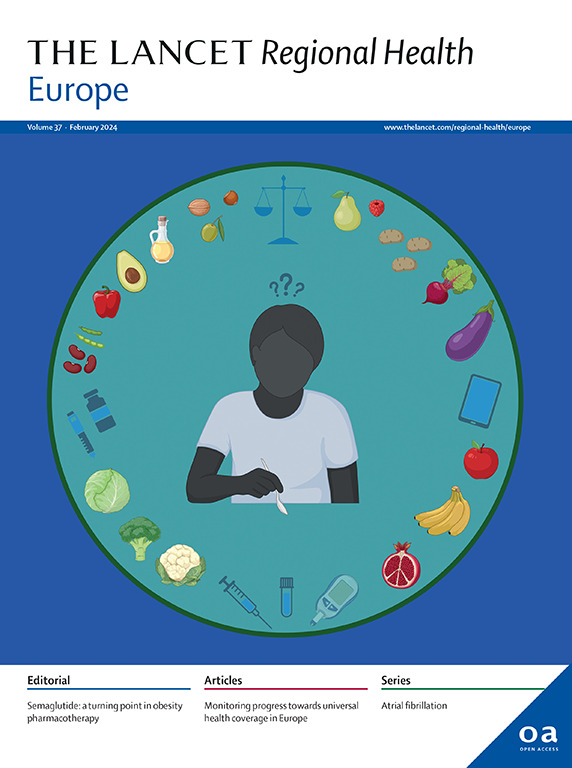Estimation of respiratory syncytial virus-associated hospital admissions in five European countries: a modelling study
IF 13.6
Q1 HEALTH CARE SCIENCES & SERVICES
引用次数: 0
Abstract
Background
Respiratory syncytial virus (RSV) can cause severe disease, notably among infants, older adults, and individuals with comorbidities. Non-systematic testing and differences in coding practices affect direct measures of the hospital disease burden. We aim to tackle this issue and estimate RSV-associated respiratory hospital admissions through time series modelling of hospital admissions.
Methods
The number of RSV hospital admissions in Denmark, England, Finland, the Netherlands, and Spain were estimated with attribution analyses, using age-specific respiratory tract infection (RTI) admissions combined with virological data, both from routinely collected healthcare data. Analyses covered the years 2016–2023.
Findings
The attributed incidence of RSV per 100,000 children 0–2 months ranged from 1715 in Denmark to 3842 in England. In older adults, substantial differences in the incidence of ICD-10 coded RSV hospitalisations were found, while the attributed RSV incidence was more comparable, ranging from approximately 100 per 100,000 in adults 65–74 years to 200 per 100,000 persons 75–84 years and 500 per 100,000 persons 85 years and older.
Interpretation
RSV-attributed time series exhibit a high degree of synchronicity between participating countries, suggesting that this method for attribution addresses the known issues with underdiagnosis and misclassification. In the older age groups, a substantial proportion of RTI hospitalisations is attributed to RSV, underscoring the relevance of RSV as a cause of severe respiratory infections.
Funding
This project has received funding from the Innovative Medicines Initiative 2 Joint Undertaking under grant agreement 101034339. This Joint Undertaking receives support from the European Union’s Horizon 2020 research and innovation programme and EFPIA.
估计呼吸道合胞病毒相关住院在五个欧洲国家:一个模型研究
呼吸道合胞病毒(RSV)可引起严重疾病,特别是在婴儿、老年人和有合并症的个体中。非系统测试和编码实践的差异影响医院疾病负担的直接测量。我们的目标是解决这一问题,并通过住院时间序列模型估计rsv相关的呼吸系统住院率。方法采用归因分析方法,利用年龄特异性呼吸道感染(RTI)入院人数和病毒学数据,对丹麦、英国、芬兰、荷兰和西班牙的RSV入院人数进行估计,这些数据均来自常规收集的医疗保健数据。分析涵盖了2016-2023年。研究结果:每10万名0-2月龄儿童的呼吸道合胞病毒发生率从丹麦的1715例到英国的3842例不等。在老年人中,发现ICD-10编码RSV住院的发生率存在显著差异,而归因RSV发病率更具可比性,65-74岁的成年人中每10万人中约有100人,75-84岁的人中每10万人中有200人,85岁及以上的人中有500人。rsv归因时间序列在参与国之间表现出高度的同步性,表明这种归因方法解决了诊断不足和错误分类的已知问题。在年龄较大的年龄组中,很大一部分RTI住院归因于呼吸道合胞病毒,强调了呼吸道合胞病毒作为严重呼吸道感染原因的相关性。本项目已获创新药物计划2联合事业资助,资助协议为101034339。这项联合承诺得到了欧盟“地平线2020”研究和创新计划以及欧洲投资与投资协会的支持。
本文章由计算机程序翻译,如有差异,请以英文原文为准。
求助全文
约1分钟内获得全文
求助全文
来源期刊

Lancet Regional Health-Europe
Multiple-
CiteScore
19.90
自引率
1.40%
发文量
260
审稿时长
9 weeks
期刊介绍:
The Lancet Regional Health – Europe, a gold open access journal, is part of The Lancet's global effort to promote healthcare quality and accessibility worldwide. It focuses on advancing clinical practice and health policy in the European region to enhance health outcomes. The journal publishes high-quality original research advocating changes in clinical practice and health policy. It also includes reviews, commentaries, and opinion pieces on regional health topics, such as infection and disease prevention, healthy aging, and reducing health disparities.
 求助内容:
求助内容: 应助结果提醒方式:
应助结果提醒方式:


